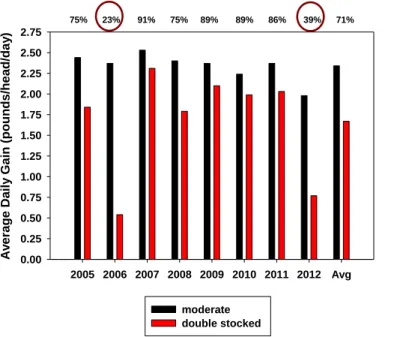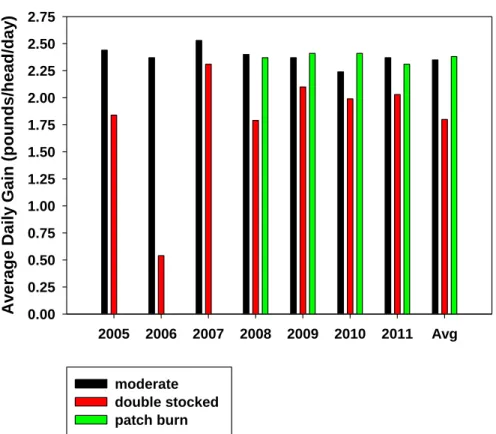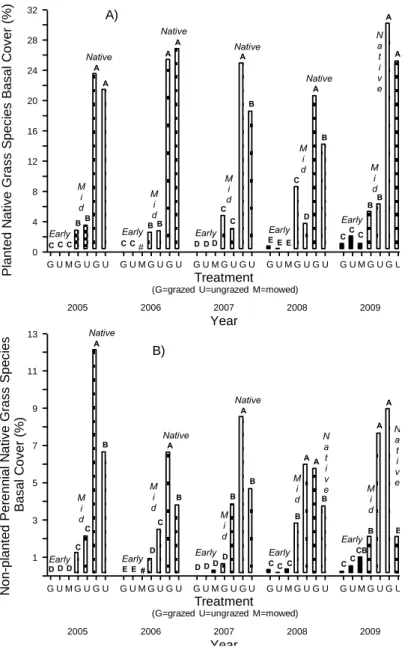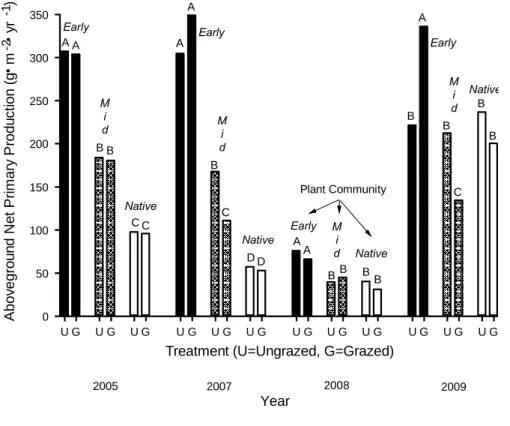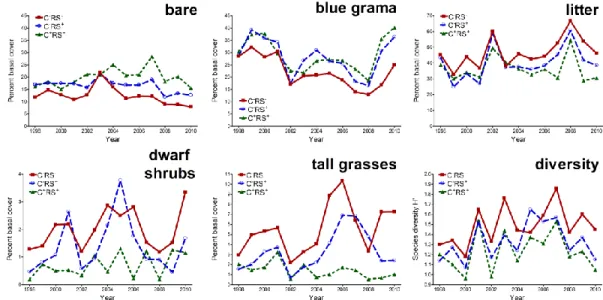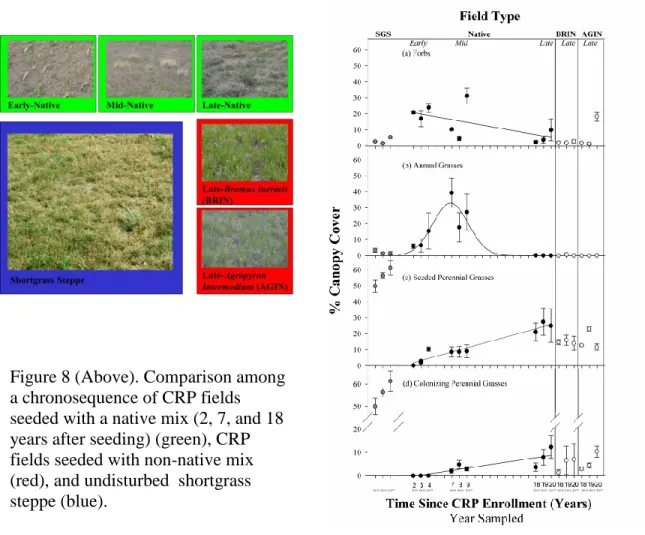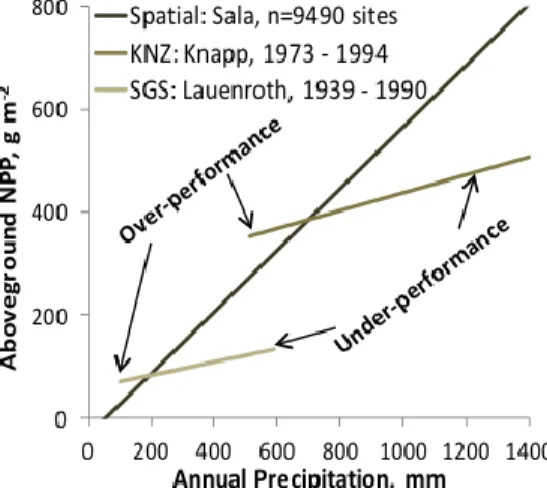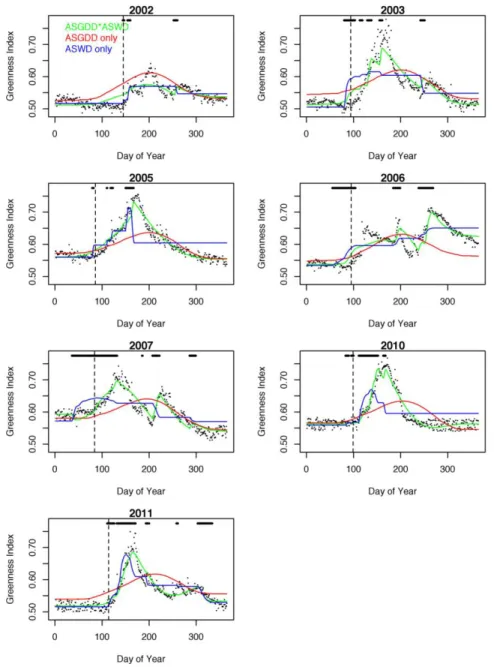SGS LTER Annual Report 2012
DEB 102731
We continue our research activities as described in our proposal and the IM supplement, as well as our efforts to decommission our site and the project. In the past year our research has led to 29 reports in peer-reviewed journals (16 published, 3 in press and 10 submitted). Our scientists have also completed one book, three chapters for additional scholarly volumes and two technical reports. Thirteen abstracts have been provided for meetings of research societies. Two PhD and two MS students have completed their dissertations/theses. Our IM team continues to prepare our experimental data sets for delivery to the LTER Network as part of our decommissioning. To date 99 of 133 datasets have been curated and are available on line. Below are the details for research, IM, outreach and project management.
A. Research Activities
Grazing StudiesGrazing Studies – Stocking Rates: In 2012, we completed the final year of a grazing
experiment evaluating the influence of double moderate stocking (doubled stocking is twice the recommended stocking rate by the Natural Resources Conservation Service and is represented by 20 yearling steers on 160 acres from mid-May to early October) on livestock production. In all years, average daily gain (pounds per yearling per day) was lower with doubled stocking compared to moderate, and the gains were precipitously lower in drought years of 2006 (23% of gain, or 77% reduction) and 2012 (39% of gain, or 61% of gain) (Figure 1). We also completed the final year of a patch burning
experiment where pairs of pastures were moderately stocked, but one pasture in each pair had 25% of the pasture burned (patch burn) in late Fall 2007-2010. Gains were similar between the pastures not burned and patch burned across years (Figure 2).
2005 2006 2007 2008 2009 2010 2011 2012 Avg A v er ag e Da il y G ai n (p o u n d s/ h ea d /d ay ) 0.00 0.25 0.50 0.75 1.00 1.25 1.50 1.75 2.00 2.25 2.50 2.75 moderate double stocked 75% 23% 91% 75% 89% 89% 86% 39% 71%
Figure 1. Average daily gains of yearling stocker steers grazing shortgrass steppe at moderate
(recommended) or double stocking rates (twice the moderate rate). Gains were precipitously lower in drought years of 2006 and 2012 with double stocking (Derner et al. in prep).
Figure 2. Average daily gains of yearling stocker steers grazing shortgrass steppe at moderate (recommended) stocking rates without any prescribed burns (moderate, black bars), moderate (recommended) stocking rates with one-quarter of the pasture burned in late fall 2007-2010 (patch burn, green bars), or double stocking rates (twice the moderate rate, red bars). Gains were similar across years for moderate stock with and without patch burning, but lower with double stocking (Derner et al. in prep).
Grazing and Stocking Rates – Precipitation: Evaluation of extreme precipitation events
on animal gains from grazing shortgrass steppe at different intensities (light, moderate and heavy) revealed contrasting responses with seasonality of precipitation. A 70-year data record was used to partition years into drought (driest 10% of years for each season of precipitation), wet (wettest 10% of years) and middle (median 10% of years), resulting in 7 years for each classification. Beef production (pounds of weight gain per acre) was determined each year for the grazing intensities using current spring (April-June) and prior growing season (April-Sept of prior year) precipitation. Classification of years into drought, middle and wet for these two precipitation classifications revealed that beef production is largely insensitive to current year spring precipitation at light and moderate stocking, but drought and wet springs have marked effects on beef production at heavy stocking (Figure 3). Additionally, drought in the prior growing season has a larger effect on beef production at light stocking and this effect lessens with increasing grazing intensity. Wet prior growing seasons have a marginal effect on beef production the following year for all grazing intensities.
2005 2006 2007 2008 2009 2010 2011 Avg A v era ge Dail y G ain ( poun ds/ hea d/ day ) 0.00 0.25 0.50 0.75 1.00 1.25 1.50 1.75 2.00 2.25 2.50 2.75 moderate double stocked patch burn
Figure 3. Beef production from yearling stocker steers grazing shortgrass steppe at light, moderate and heavy intensities in drought (lowest 10% of years), wet (wettest 10% of years) and middle (median 10% of years) for two different seasons of precipitation: (left) prior growing season of April-September, and (right) current year spring precipitation of April-June (Derner et al. in prep).
Grazing and CRP succession - plant community composition: Grazing may speed or
slow secondary succession and the direction may depend on seral stage and relative tolerances of native perennial grasses compared with annual invasive species. How does grazing affect succession where undisturbed communities have a long evolutionary history of grazing by native herbivores and are tolerant to livestock grazing? Ungrazed and grazed early-seral (4-6 yr) and mid-seral (18-20 yr) seeded fields (Conservation Reserve Program) and traditionally grazed native steppe were compared for effects on plant composition in relation to changes expected from regional succession models.
Recovery towards undisturbed native shortgrass steppe for early- and mid-seral communities, respectively, were 19 and 36% for total vegetation cover, 5 and 21% for planted native species, 10 and 88% for non-planted native perennial grasses, only 0.2 and 13% for short grasses, and overall dissimilarity in community species compositions of 97 and 68% (Figure 4). In general, grazing effects were neutral or most often not significant in all years and/or were small in overall community magnitude. The early-seral
community displayed more changes indicative of a slowing of succession with grazing (total vegetative and grass basal cover) rather than reducing invasive species (species targeted by timing of grazing), but drought had limited establishment of grazing-tolerant short grasses. The mid-seral community showed more changes consistent with advancing successional recovery with grazing (overall community dissimilarity, forbs, planted native perennial grasses, tall grasses, and target species). However, non-planted native
Previous Growing Season Precipitation
(April-Sept)
Grazing Intensity
light moderate heavy light moderate heavy
B eef P roduction (pounds/acr e) 0 5 10 15 20 25 drought middle wet Spring Precipitation (April-June)
perennial grasses responded negatively to grazing in the mid-seral community and positively in native shortgrass steppe where outside seed would originate.
Grazing effects on particular functional groups and species were not the same across seral stages, were mixed in terms of speeding or slowing succession, and were generally not large at the community level. Evolutionary history of grazing may serve as a general guide but decisions as whether to graze successional grasslands may best be made after assessing established tolerant perennial species. Monitoring may then be necessary to determine species responses in particular community matrixes and effects on subsequent immigration of non-seeded native perennial species.
Figure 4. Basal cover (%) of A) planted native grass species and B) non-planted perennial native grass species in early-seral and mid-seral seeded grassland and native shortgrass steppe in grazed, ungrazed, and mowed treatments for five years. The first two years for seeded grasslands were pre-treatment. Bars within a year not sharing a common letter are significantly different.
G U M G U G U G U M G U G U G U M G U G U G U M G U G U G U M G U G U 32 28 24 20 16 12 8 4 0 Treatment P la n te d N a ti v e G ra s s S p e c ie s B a s a l C o v e r (% )
(G=grazed U=ungrazed M=mowed) Year 2007 Early M i d Native Early M i d Native Early Native Early Early N a t i v e M i d M i d M i d Native # 2005 2006 2008 2009 A A BB C C C A A B B C C A B C C D D D A B C D E E E A A BB CCC G U M G U G U G U M G U G U G U M G U G U G U M G U G U G U M G U G U 13 11 9 7 5 3 1 Treatment N o n -p la n te d P e re n n ia l N a ti v e G ra s s S p e c ie s B a s a l C o v e r (% )
(G=grazed U=ungrazed M=mowed) Year 2007 Early M i d Native Early M i d Native Early Native Early Early N a t i v e M i d M i d M i d N a t i v e 2005 2006 2008 2009 A B C C D D D A B D C E E # A B D B D D D C C C A A B B CC CB A A B B A) B)
Grazing and CRP succession - ANPP/roots: Annual/perennial and tall/short plant
species differentially dominate early to late successional shortgrass steppe communities. Plant species can have different ratios of above-/belowground biomass distributions and this can be modified by precipitation and grazing. We compared grazing effects on aboveground production and root biomass in early- and mid-seral fields and undisturbed shortgrass steppe (Figure 5). Production averaged across four years and grazed and ungrazed treatments was 246, 134, and 102 g m-2 yr-1 for the early-, mid-seral, and native sites, respectively, while root biomass averaged 358, 560, and 981 g m-2, respectively. Early- and mid-seral communities provided complimentary forage supplies but at the cost of root biomass. Grazing increased, decreased, or had no effect on aboveground
production in early-, mid-seral, and native communities, and had no effect on roots in any. Grazing had some negative effects on early spring forage species, but not in the annual dominated early-seral community.
Dominant species increased with grazing in native communities with a long evolutionary history of grazing by large herbivores, but had no effects on the same species in mid-seral
Figure 5. Aboveground net primary production (g m-2 yr-1) in early-seral and mid-seral seeded grassland and native shortgrass steppe in ungrazed and grazed treatments for four years. The year 2005 for seeded grasslands was pre-grazing-treatment, while all years are for grazing treatments at the native site. Bars within a year not sharing a common letter are significantly different.
U G U G U G U G U G U G U G U G U G U G U G U G 350 300 250 200 150 100 50 0
Treatment (U=Ungrazed, G=Grazed)
Year 2008 Early M i d Native Early M i d Native Early M i d Native Early M i d Native 2005 2007 2009 Plant Community A A B B C C A A B C D D A A BB BB B A B C B B A b o v e g ro u n d N e t P ri m a ry P ro d u c ti o n ( g m y r ) -2 -1
.
.
communities. Effects of grazing in native communities in a region cannot necessarily be used to predict effects at other seral stages.
Large/small herbivore grazing: The response of semiarid grasslands to small,
non-colonial herbivores has received little attention, especially compared to studies of interactions between granivores and desert annual plant communities. We studied the importance of small and large herbivores on vegetation structure and diversity of shortgrass steppe, a perennial semiarid grassland with a long evolutionary history of grazing by large herbivores, but considered marginal habitat for small mammalian herbivores. We hypothesized that 1) small herbivores would affect less common species through selective but limited consumption, 2) large generalist herbivores would affect more abundant species and gross plant community characteristics through non-selective intense levels of herbivory, 3) both small and large herbivore effects on plant richness increase with increasing aboveground net primary production (ANPP) because rare species would be more abundant in wet years. Plant community composition was assessed over a 14-year period (1998-2011) in pastures grazed at moderate intensities by cattle and in exclosures for large (cattle) and large-plus-small herbivores (additional exclusion of rabbits and rodents).
Exclusion of large herbivores affected ground cover (litter and bare ground) and basal cover of abundant, common and rare species (Figure 6). In contrast, total vegetation cover, species dominance, total species richness, and species diversity were not
influenced. Additional exclusion of small herbivores, which increased in abundance during the course of our study, did not affect rare components of the plant community, but had indirect effects on abundant species, decreased the cover of the dominant grass
Bouteloua gracilis and total vegetation cover, and increased litter and species diversity.
Although species richness increased with increasing ANPP, the impact of either large or small herbivores on plant richness was small and there was no relationship between
ANPP and the intensity of effects of either herbivore type on richness. Exclusion of herbivores of two different body-sizes had primarily complementary and additive effects which promoted changes in the same direction for vegetation composition and
physiognomy due to the increase of tall species and the decrease of short species. Both large and small herbivore grazing promoted recovery of short grasses after intense droughts, providing resilience to the shortgrass steppe and contributing to the long-term maintenance of basal cover of total vegetation. Small mammal herbivores had
disproportionately large effects on plant communities relative to their small consumption of biomass, suggesting they be considered in understanding structure and diversity in semiarid perennial grasslands with a long evolutionary history of large herbivore that are traditionally considered a marginal habitat for these mammals.
Do interactions between large and small herbivores mediate effects of climate change on SGS plant communities? The effects of cattle grazing on shortgrass-steppe (SGS)
plant communities are well-established, but the roles of smaller herbivores, such as rabbits and small rodents, remain poorly understood. Small herbivores consume less plant biomass overall, but may be more selective, and may be an important source of soil disturbance. Both of these factors may alter the abundance of rarer plant species, either directly or indirectly, by influencing the dominance of blue grama, the foundation species in this system (Figure 7). Past SGSLTER research suggests that climate change may alter the distribution of cool-season grasses and shrubs, especially at the northern boundary of SGS with mixed-grass prairie, and we have evidence of increases over the past decade in the abundance of these plant groups. Herbivory may alter the trajectory of these changes, but the independent and synergistic effects of large and smaller mammalian herbivores are not known. In turn, increases in the distribution and abundance of cool-season grasses and shrubs may alter habitat and food resources for consumers that are sensitive to vegetation structure.
In 2012 we established a new experiment (CAREX; CAttle and Rabbit
EXclosures) to investigate the interactions between small and large herbivores and their effects on SGS plant communities. The main objective of this large-scale, long-term (10+ years) experiment is to quantify the effects of small and large herbivores, singly and in combination, on plant community dynamics and vegetation structure. Given recent and projected changes in plant community composition at CPER, we will focus particularly on changes in abundance of cool-season grasses and shrubs. At five separate locations we established a series of four 45-x-45 m plots, representing four treatments that differ in access to cattle (C) and rabbit (R; rabbits). Three plots are exclosures: C-R+, cattle excluded with barbed wire fence; C+R-, rabbits excluded with chicken wire and barbed wire, with individual steers added intermittently to provide grazing; C-R-, both cattle and rabbits excluded by chicken wire and barbed wire. An adjacent plot serves as an unfenced control that is accessible to all herbivores (C+R+). In addition, 10-x-10 m hardware-cloth exclosures will be erected in each plot to separate the effects of rabbits from small rodent herbivores (kangaroo rats, ground squirrels, pocket gophers; S-). In each plot we measure basal and canopy cover, density of cool-season grasses, cactus and shrubs, vegetation height, and shrub area. We also record the density and size of animal
burrows and soil disturbances, as well as the number of rabbits and pronghorn pellets as an index of herbivore activity.
Plant community and ecosystem change on Conservation Reserve Program lands in Northeastern Colorado: The Conservation Reserve Program (CRP) has restored
cultivated fields to perennial grasslands on over 2.3 million acres in Colorado, primarily in regions of semiarid shortgrass steppe. Challenges to overcome slow recovery potential of shortgrass vegetation have resulted in many CRP seed mixtures that contain introduced species not native to Colorado. The objective for our research was to assess the state and rate of recovery of both plant community and ecosystem variables on CRP lands relative to undisturbed shortgrass steppe. Here we report plant community, above and
belowground net primary production (ANPP, BNPP), and soil properties over a
chronosequence of CRP sites (Figure 8). Species composition shifted from a species rich annual grass and forb community to a perennial grass community (Figure 9) with lower richness if the field was planted with non-native species. 18 year-old CRP fields planted with native species more closely resembled uncultivated shortgrass steppe in functional composition, plant density, and basal cover than those planted with non-native species. ANPP and BNPP, basal cover, and litter increased in CRP fields over time, while plant density decreased. Our findings demonstrate ANPP production on 18 year-old non-native CRP fields is nearly double uncultivated shortgrass steppe, despite half the species richness. However, a tradeoff of high ANPP for non-native plants in a low resource environment was lower plant density and BNPP. Soil carbon and nitrogen increased at
Figure 7. Results from one of our long-term grazing experiments (GZTX) revealed different effects of small and large herbivores on % cover of substrate and key plant functional groups and plant species diversity. In this experiment, exclosures eliminated cattle only (C-, blue dashed lines, open circles) or both cattle and all small herbivores collectively (RS-, red solid lines, squares), and therefore could not separate the effects of rabbits (R) from other small herbivores (S). Controls were open to all herbivores
low rates of 2 g C m2 y-1 and 0.02 g N m2 y-1 across the CRP chronosequence, and this increase was higher under native compared to non-native seeded perennial grasses.
Precipitation Studies
Environmental vs. biotic constraints on ecosystem recovery following extreme drought:
How do plant community, soil biogeochemistry and water reserves change with inter-annual variability in precipitation? The importance of precipitation for explaining spatial patterns in production is best illustrated in the iconic study of Sala et al. (1988). From a
Figure 8 (Above). Comparison among a chronosequence of CRP fields seeded with a native mix (2, 7, and 18 years after seeding) (green), CRP fields seeded with non-native mix (red), and undisturbed shortgrass steppe (blue).
Figure 9 (Right). Mean percent canopy cover (± SE) of forbs (a), annual grasses (b), seeded perennial grasses (c), and colonizing perennial grasses (d) in SGS, and in relation to time since CRP enrollment in the chronosequence of CRP fields seeded with native perennial grasses (Native-Early, Mid, and Late), and CRP fields seeded with introduced grasses: Bromus inermis (BRIN-Late) and Agropyron intermedium (AGIN-Late), from 2005 to 2007.
database of >9,000 sites across the U.S. Great Plains, they found that mean annual precipitation explained 90% of the variation in time-averaged aboveground net primary production (ANPP). Precipitation also appears to drive the temporal pattern for inter-annual variation in ANPP within sites, but the story becomes more complex and interesting here (see Figure 7). At both the dry Shortgrass Steppe grassland in eastern Colorado and at the wetter Konza grassland in eastern Kansas, inter-annual variation in ANPP was positively correlated with precipitation, but the slope of the temporal
relationships were much shallower such that, in wet years, ANPP under-performed as compared to the spatial pattern, while in dry years ANPP over-performed (Lauenroth, Knapp).
Previous studies have generally attributed the difference between spatial and temporal responses to differences in the local species pool. The reasoning is that, as MAP in creases, species sorting effects will entrain new plant species that are better
adapted to take advantage of the increased precipitation. For example, the dominant grass on the Shortgrass Steppe, Bouteloua gracilis, reaches a maximum height of ~35cm, while the dominant grass at Konza, Andropogon gerardii, can grow to >2m tall. While this reasoning works to explain the underperformance of ANPP during wet years, it cannot explain over-performance in dry years. Instead, we argue that the overall spatial-temporal pattern arises because the ANPP of a site is buffered against interannual variability in precipitation as compared to the spatial pattern. This buffering can arise when the legacy of precipitation history allows a local plant community to develop an “infrastructure” for converting precipitation into biomass. This infrastructure, comprised of plant infrastructure (e.g., root biomass, crown meristems and seeds) soil nutrient dynamics and deep water storage, achieves a magnitude commensurate with the average precipitation of the site. Then during dry years, the relatively large infrastructure allows for greater precipitation capture and growth as compared to a site that is always that dry; likewise in wet years there is insufficient infrastructure to utilize the precipitation as effectively as sites that are usually wetter.
Figure 10. The relationship between annual precipitation (mm) and aboveground NPP (g m-2) across multiple sites (Sala, n=9490), the KNZ-LTER (Knapp, 1973-1994), and the SGS-LTER (Lauenroth, 1939-1990).
Soil Water and Temperature Explain Canopy Phenology and Greenness in a Semiarid Steppe: (Funded on this award and our previous award DEB 0823405. Results
presented in both reports to reflect the continuing activity.) In the US Great Plains,
biomass seasonality is variable and depends on either temperature or precipitation, depending on which remains limiting as spring progresses. Primary production in the shortgrass steppe is positively related to precipitation, but the influence of temperature is dependent on precipitation and the combined effects determine water availability. In water-limited ecosystems such as the shortgrass steppe, the timing of the onset of spring very likely reflects a response to both temperature and precipitation. In the shortgrass steppe, surface reflectance measurements and derived vegetation indices combined with on-site or nearby climate data can be used to gain a detailed understanding of how the timing of plant growth is influenced by temperature and precipitation. The overall goal of this study is to address questions about relationships between the timing of plant growth, soil temperature, and soil water using surface reflectance measurements. Specifically, how do soil water and soil temperature individually and jointly influence the timing of the onset of spring and peak greenness on the shortgrass steppe?
In this study we compare 7 years of plant canopy development. We used two-channel radiometers and measured reflected radiation in the red and near infrared wavelengths on ungrazed shortgrass steppe. Reflectance measurements were polled daily, averaged and stored. We used these data to calculate a response variable, the greenness index. Precipitation, air temperature, soil water and soil temperature were measured daily on-site and nearby. We calculated soil-growing degree-days and accumulated soil water days as explanatory variables.
We found that accumulated soil water and accumulated soil temperature individually influence the timing of green up and peak growth. We determined that a matric potential close to field capacity is necessary to initiate the onset of spring on the shortgrass steppe. We found that the onset of spring was delayed 60 days during an extreme drought year when compared to average precipitation years. We found that a multiple regression mixed-effects model including both explanatory variables showed the best fit to the measured GI for all years, clearly demonstrating that a model including both accumulated soil temperature and accumulated soil water is necessary to explain the seasonal dynamics of the GI (Figure 11).
Figure 11. Predicted greenness index vs. observed greenness index for the soil temperature only, soil water only, and the full model, for 7 years.
Multiple regression models were able to elucidate pulses in greenness, but only when considering the combined influence of soil water and soil temperature (Figure 12). The results of this research illustrate how important precipitation is when estimating
phenological metrics such as growing season length and peak growth in arid and semiarid systems.
Figure 12. Greenness index plotted over time (DOY) for the GI data (points),
phenology models for soil temperature only (red), soil water only (blue), and the full model (green) for 7 years. Dotted line is onset of spring. Black bars along top show days when soil water content was above base value (minimum value of soil water required to initiate a phenological response).
Climate change and plant species composition and community structure in the central grassland region of North America: In grassland ecosystems, where soil water most
frequently controls ecosystem processes, expected changes in precipitation and
temperature may have dramatic effects on ecosystem dynamics. Previous observational studies have reported that aboveground net primary production (ANPP) in grasslands is very sensitive to changes in precipitation. Yet we lack experimentally based evidence to support these observations. Further, most studies have focused solely on ANPP,
neglecting belowground production (BNPP). This is an important gap in our knowledge, as BNPP represents 50% or more of total net primary production (NPP) in grasslands. Here, we present results from a 3-year water manipulation experiment (2008 - 2010) at two sites in the central grassland region of North America, USA. We were successful in changing the soil water content in our treatments, but these changes resulted in different, but significant responses in ANPP and BNPP at our two sites. At the shortgrass steppe, we found that neither NPP nor ANPP were sensitive to treatment precipitation, and while we found BNPP was sensitive to changes in treatment precipitation, the direction of the response varied between years (Fig. 13a). In contrast, ANPP was very sensitive to treatment precipitation on the mixed grass prairie, while BNPP was insensitive (Fig. 13b). Based on our finding that two grassland ecosystems showed dramatically different above and belowground production responses to soil water manipulations, we cannot assume that predicted changes in climate will cause similar above and below ground production responses. Second, our results demonstrated that sites within the same region may differ markedly in the sensitivity of ANPP to changes in growing season
B. Information Management
(Nicole Kaplan, Information Manager and Bob Flynn, GIS and IT Manager)
Nicole Kaplan and Bob Flynn are working with SGS-LTER Researchers on information management in support of data integration, QAQC and metadata documentation to facilitate publication of scientific findings in peer-reviewed journals and data
accessibility through the LTER Data Portal. We established five focus areas with the objectives first to improve data access and metadata documentation in accordance with the recommendations in the 2012 LTER revised guidelines (network communication, LTER Executive Board); second to preserve the local knowledge of scientists, staff and students who have worked on the SGS-LTER research site; and third to make the acquired information available for future researchers and citizens. These focus areas represent the majority of our efforts and we report on our activities and accomplishments in more detail.
Improve Data Access: Complete the delivery of Level 5 EML 2.1.0 compliant metadata
and data of SGS-LTER core datasets as data packages through the LTER Data Portal at the LTER Network Office while satisfying existing best practices and standards for the LTER Network.
SGS-LTER researchers and staff have created an inventory of core datasets to be preserved and made available through the LTER Network Data Portal. This inventory consists of 150 datasets that represent over thirty years of interdisciplinary research. The curation of this information will help build future capacity for understanding the structure and function of shortgrass steppe. Nicole and Bob continue to increase our web data delivery locally with online public access to data and accompanying high-level metadata content in Ecological Metadata Language (EML v2.1.0), built on emerging best practices and standards for the LTER Network.
Assurance of SGS-LTER Data Integrity: Perform QAQC and data integration for data
packages developed through Focus 1 and provide additional supporting documentation that reflect important contextual information regarding changes in methodologies, research objectives and findings, and appropriate reuse of data.
We work closely with SGS and other LTER site researchers and graduate students on ensuring data quality. We are performing data integration for longitudinal studies and data aggregation to create a complete dataset over the range of sampling dates and locations. We are performing QAQC procedures, including exploratory summary
statistics on the data, which get reported to the responsible Principal Investigator. We are Figure 13. (a) Shortgrass steppe NPP, and (b) mixed grass prairie NPP, in drought, control, and water addition treatments. Uppercase letters represent differences within a given treatment between years, and lowercase letters represent differences between treatments within a given year. Differences significant at P<0.05, but * indicates significance at P<0.10. Bars represent standard error. Differences in ANPP are shown above the NPP bars, differences in BNPP are shown below the NPP bars, and differences in NPP are shown within the NPP bars.
implementing LTER standards and following EML best practices as we are generating data products as tabular data, metadata packages and spatial data within our Geographic Information System (GIS). We are worked closely with SGS-LTER field crew leaders and our partners at the Agricultural Research Service to collect more precise information regarding the location of historical experimental treatments, fence lines and other land or project management attributes to create a more useful digital record of long-term study sites on the Central Plains Experimental Range for the future. We began planning and implementing steps to transition the SGS website for better long-term support and maintenance as the SGS-LTER project phases out.
PASTA Compliance: Ensure that SGS-LTER data packages are interoperable with the
network infrastructure and the emerging PASTA Framework.
We have made updates to our EML generation system, which include a relational database management system that contains all of the metadata content, and a PERL script and an XSLT style sheet to generate valid Level 5 EML 2.1.0 data packages that can be integrated into the PASTA framework. The current structure and content is being
improved to comply with EML best practices for Level 5 EML 2.1.0. This will allow the Network Data Portal to better serve data packages and automate processing of site data sets with the PASTA framework. We are working with our partners at the Natural Resource Ecology Lab at Colorado State University and the LTER Network Office to determine the best URL location to curate and serve data sets well into the future. We have worked to improve the functionality of the SGS-LTER system, availability of the SGS-LTER data, richness of the SGS-LTER metadata, and functionality of the LTER NIS as a whole. We understand that the investment we make as a site in the improvement of the quality and quantity of the data will go a long way in illustrating the wealth and accessibility of LTER data and enabling synthesis of SGS-LTER data in Network research.
Network Information System (NIS) Participation: Extend our involvement in the LTER
NIS development initiatives by participating in the broader information management community as a member of the LTER Network.
Enabling data integration by providing open access to data and useful metadata documentation is critical for the NIS to support collaborative research activities in the network. We continue to participate in the development of the NIS by staying engaged in NIS activities, attending virtual discussions, and identifying datasets where
documentation needs to be improved in response to new guidelines from the LTER EB. We also continue to contribute high quality data packages to cross-site science endeavors and Network databases (e.g. ClimDB, vegDB, MALS) to ensure that the SGS-LTER participates as experienced LTER scientists and information managers. Nicole
participated in the 2012 Annual Information Management Meeting and working groups at the All Scientists Meeting, in Estes Park, Colorado. Nicole also served as the co-founder of the Information Management Governance Working Group (GWG). The GWG
prepared the Information Management Committee Terms of Reference, which was adopted by the LTER IMC in September 2011. Nicole and Karen Baker (PAL, CCE) lead this effort in recognition of the importance of ensuring effective governance for the
LTER Information Management Committee, because the number of members and work of our community has grown significantly to address the development and adoption of best practices and standards impactful to the 26 LTER sites currently in the Network. Governance for information management systems and organizations will continue to be important as more principal investigators require management and open access of their data and information.
Preservation of SGS-LTER Legacy: Collect and share stories from individuals, scientists
and support staff who have worked on the shortgrass steppe with the LTER project over the course of their career, which represents an important pool of knowledge about the site and progression of the science.
Nicole is leading an effort to collect stories from scientists, graduate students and support staff who have been associated with the site. Nicole is collaborating with Helena Karasti (Finnish LTSER Network), an interdisciplinary scholar located at University of Oulu, Finland and Luleå Technical University, Sweden, who has worked with LTER networks since 2002. Dr. Karasti was invited as an ILTER participant at the 2012 LTER ASM in Estes Park. Starting at ASM and continuing the following week, Helena and Nicole conducted an initial set of over twenty interviews and group discussions with LTER scientists, staff and alumni. The interviews elicited views and accounts on how career building has intertwined with the SGS-LTER and the LTER Program, science leadership and institutional context, and approaches to conducting collaborative research over the long-term. The interviews also offered an opportunity to raise issues related to the decommissioning of a site in the US LTER Network. These ideas are being compiled to communicate The Science Stories Behind the Data – A Biography of the SGS-LTER. Different perspectives provide insight about conducting science over the long-term in the shortgrass steppe and historical features of the LTER Network. It is also an opportunity to recognize formally contributions SGS-LTER has made to science and to the LTER Program.
C. Education, Outreach, and Training Activities
In the 2011-2012 school year, four LTER Schoolyard mini grants were given to schools in Poudre and Weld County District 6 School Districts. We provided stipends to 18 teachers during the 2011-2012 school year for professional development activities, workshops and/or research internships. Below is a summary of the science education projects that the Schoolyard project supported in middle and high school classes. Cache La Poudre Middle School received funding from Schoolyard for two projects during the year. Funding allowed the school to purchase equipment that led to
approximately 170 6th and 7th grade students learning about river chemistry and carbon cycling. This provided students the opportunity to use state-of-the art technology to gather and analyze data more accurately. Students also learned how water quality affects the ecology of a community by conducting several water quality tests that included hardness, turbidity, dissolved oxygen, pH, temperature and biodiversity. In addition, students grew plants and learned how carbon is important in biological systems, how
matter and energy can be traced in biological systems and how scientists use multiple scales to connect biological systems.
Funding for a second project supported a teacher in expanding a 7th grade geography unit based on map making and learning GPS skills. She was able to incorporate the concepts of fragmentation and behavioral observation with curriculum development time and purchasing supplies. Funding was used to develop curriculum and supplies to incorporate a field experience into a science classroom and in 7th grade
Geography classes. Students learned how to read topographic maps, used GPS units to mark locations around campus and then to locate items around the campus with specific coordinates. Students then learned to analyze graphs to determine the movements of students using accelerometers. In addition, students worked on their observations skills by viewing videos of wildebeest behavior made while the teacher participated in a research project with an NREL scientist. Students learned about the migration of the wildebeest in their historic ranges and how their migration is affected by fragmentation. At the end of the unit, an assessment was given where students reflected on their learning by assessing their understanding of the importance of science in their everyday lives and how they are stewards of the Earth and everything necessary for life.
Kinard Middle School received funding to pay for substitute teachers so that approximately 250 students could take a field trip to the Poudre Learning Center to engage in water quality testing on the Poudre River and in the lake on site. Students made leaf bags in class prior to the trip and the teacher was able to submerge them in the river and lake prior to the student field trip where they were collected and dissected for evidence of decomposition. Doing this activity allowed students to compare water quality in the lake versus the river. In addition, 3 stations were set up on the property: a math station where a students set up an area quadant and determined percentages of vegetation types(?); an English/art station where students reflected on specific prompts; a history station where students learned about the history of the Cache la Poudre River. At the end of the field trip, students were presented with an ecological issue relating to the Poudre River in order to make connections between the unit and student’s lives. The goal here was to use the knowledge they gained during the unit and field experience to help solve a real-world problem.
Union Colony Middle School and Union Colony Preparatory School received funding to offset the cost of the composting and recycling program at Union Colony schools and start science clubs at the middle and high school level. Students in the science clubs will be directly involved in running the recycling and composting program. Funding also supported the biodiversity unit that was implemented in 6th and 9th grade science classes. Students in the science clubs will be directly involved in running the recycling and composting program.
Union Colony Schools set a goal to continue a school-wide compost and recycling program. Through this program staff and students were educated about the benefits of composting and recycling. The schools worked with the local company Clean Air Compost to provide students and teachers education and awareness about what can be composted and how to properly divert compostable materials, the positive environmental impact of diverting waste from landfills, and the value of compostable waste as an
important resource and crucial nutrient source for local agriculture, farming, and streamside restoration.
In creating a science club, students were empowered to take leadership of the composting and recycling program at their schools. The science club would be
responsible for collecting, sorting, and shipping recyclable items. Funding for science club also allowed for student participation in service learning projects such as adopting sea turtles, completing projects at the Poudre Learning Center, and mentoring younger students with science projects.
D. Project Management
Project management at SGS-LTER continues as it has since it was changed in 2009. Central management of the project is by an Executive Committee (SGS-EC), Mike Antolin (lead PI until 11/1/2010), John Moore (lead PI since 11/1/2010), Justin Derner, Eugene Kelly, and Nicole Kaplan (Information Manager). The Executive committee works with the PI’s, both to manage project budgets and to map out the general scientific directions of the project. Justin Derner is a scientist with the USDA ARS Rangeland Resource Research Unit (ARS-RRU) stationed in Cheyenne, WY, and represents our partners with the Central Plains Experimental Range where the majority of SGS LTER research has been conducted. We use video-conferencing to include members from several institutions at different locations.
Under this award the SGS LTER has two ongoing subcontracts: with
collaborators at the University of Wyoming (Drs. Indy Burke and William Lauenroth) for continued work on long term ANPP and plant phenology, long-term biogeochemistry and climate manipulation experiments; and with our USDA-ARS collaborators (Drs. Justin Derner, David Augustine, Dana Blumenthal and Jack Morgan) to continue long-term experiments on the Central Plains Experimental Range.
